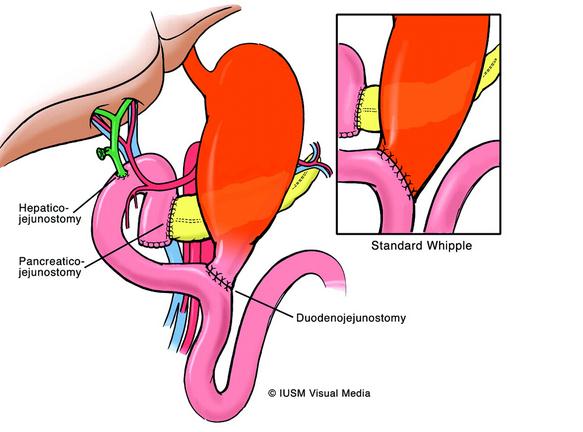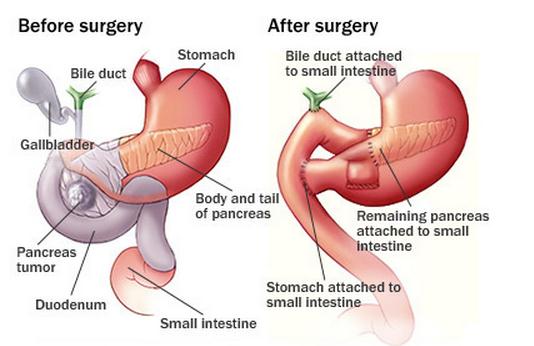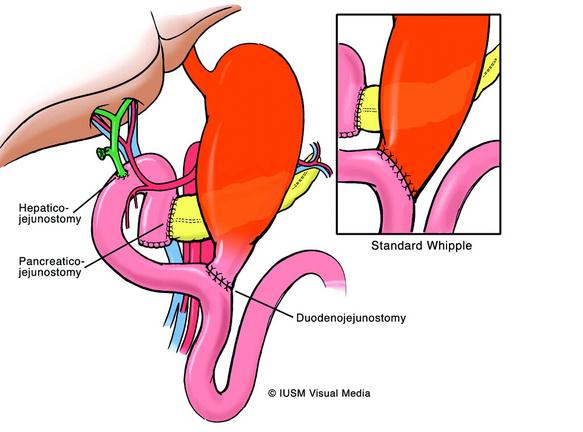Whipple Procedure – Complications, Prognosis, Survival Rate, Pictures
What is Whipple Procedure?
Named after an American surgeon, Allen O. Whipple is a surgery called Whipple Procedure also called Pancreaticoduodenectomy. A Whipple procedure is a surgical operation done primarily for Pancreatic Cancer patients. The procedure is usually done so as to remove an enlargement on the duodenum. The duodenum is the first section of the small intestine, or in layman’s terms, the small bowel. It can be the removal of bile duct or head of the pancreas. It can also be done for patients with chronic pancreatitis or for those patients who have bile duct or pancreatic duct strictures.

The physician will explain and illustrate a drawing of the sections of the body involved for the patient to see.
The whole procedure is usually completed in four to six hours. The patient may possibly need a blood transfusion at some stage in the procedure. The surgery can include detaching one or more of the following:
- Gallbladder
- Section of the bile duct
- The duodenum
- Head of the pancreas
- Inferior section of the stomach.
Whipple Procedure for Pancreatic Cancer
- The Whipple procedure is a possible choice for patients who have pancreatic cancer but only if the cancer has not spread past the pancreas. This is an extensive and difficult surgery that is intended to eradicate the entire malignant cells or cancer cells.
- It includes detaching the head of the pancreas, normally located deep within the abdomen.
- Additionally, a segment of the bile duct, the gallbladder and the duodenum are also detached.
- Afterward, the surgeon needs to put back the pancreas, the intestine and the remaining bile duct, called “the reconstruction”.
- The reconstruction will permit the patient to consume food and digest food just as before the surgery.
- Usually, a Whipple procedure it will include the surgical removal of a section of the stomach. If the stomach during the Whipple procedure is not removed, then the surgery is called the Pylorus-Preserving Whipple.
Complications
Pancreatic Fistula
Pancreatic fistula can be a complication of Whipple procedure. This happens if there are problems during the healing process of the suture that connects what remains of the pancreas to the intestine.
Leakage of pancreatic juice
Subsequently, leakage of the pancreatic juice can occur. In most cases, the leakage will repair on its own without requiring another surgery. However, in rare cases, another operation might be needed to repair the leak.
Stomach paralysis
Furthermore, 25 out of 100 patients can have stomach paralysis after the procedure. However, one normally recovers in four to six weeks time. In cases of stomach paralysis, the patient is required to temporarily obtain nutrition through a feeding tube.
Side Effects
The usual long term side effects of a Whipple procedure are problems with digestion, such as:
- Diabetes
- Malabsorption
- Weight loss.
Diabetes
After the surgery, diabetes may manifest in the patient who has undergone the surgery. Diabetes is a metabolic problem wherein the body does not produce insulin or lacks insulin to control blood glucose. This can happen in Whipple procedure patients because insulin production will be reduced once a part of the pancreas is removed. This will also be a big problem if the patient already has diabetes before the surgery, for it may worsen their condition.
Malabsorption
Malabsorption can also take place after the surgery. In malabsorption, the patient often has issues absorbing nutrients because when a part of the pancreas is removed it also reduces the number of pancreatic enzymes that it produces. These pancreatic enzymes are essential for good digestion and absorption.
Weight loss
Patients who have this problem is often caused by frequent diarrhea with oily and bulky stools. Pancreatic enzyme supplements taken orally can provide a relief when taken on a long-term basis.
5 percent to 10 percent weight loss can also happen. The reason for the weight loss is patients have a limited diet after the procedure. The good news is their normal weight will return once they are allowed to eat normally again.
Prognosis
Pancreatic cancer rarely happens, but once there is a diagnosis, it will be a struggle to fight it.
Only 5 out of 100 diagnosed with pancreatic cancer live after five years with it, compared to 66 out of 100 colon cancer patients and 90 out of 100 female breast cancer patients. However, there’s a better chance of surviving the cancer because of the Whipple Procedure. It is the most frequently used treatment for this disease.
During the 1970s, 15 out of 100 of the patients died while undergoing the Whipple procedure or soon after the procedure. However, new developments in anesthesia, surgical practice, and care after surgery have greatly reduced the fatality rate during and after the procedure.
Also, survival rate increased to 20% rather than 5% after having the operation.
Survival Rate
There is a correlation between survival rate and experience of both hospitals and surgeons. According to the study from John Hopkins and Memorial Sloan Kettering, there is less than 4% death rate in hospitals that perform a great number of Whipple procedures in a given year. They have found out that hospitals that perform fewer Whipple operations may have a significantly higher fatality rate.
Therefore it is recommended that one choose a hospital that is highly experienced with this procedure.

